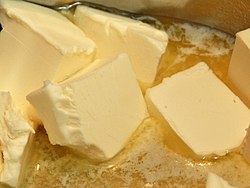
A butter dish is defined as "a usually round or rectangular dish often with a drainer and a cover for holding butter at table". [1] Before refrigerators existed, a covered dish made of crystal, silver, or china housed the butter. [2] These butter dishes were made to hold the traditional round shape of butter at the time and came with an "ice chamber" to keep the butter cold. [3] Another type of butter dish, a French butter dish, keeps butter fresh by using water to keep the butter away from the air, thereby keeping it fresh. [4] The water is placed into the base of the dish and the butter is put into a bell-shaped lid, creating an air seal. [5]
